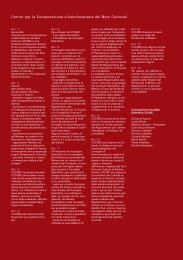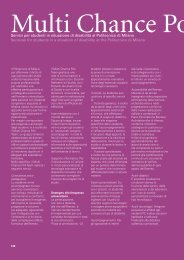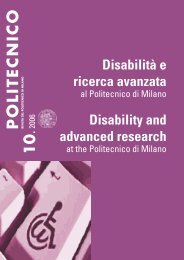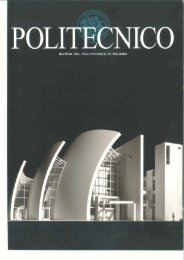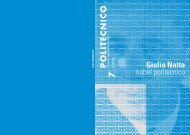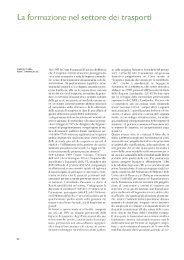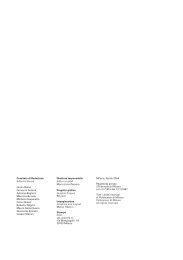POLITECNICO
Scarica il PDF (5174KB) - Rivista Politecnico - Politecnico di Milano
Scarica il PDF (5174KB) - Rivista Politecnico - Politecnico di Milano
- No tags were found...
Create successful ePaper yourself
Turn your PDF publications into a flip-book with our unique Google optimized e-Paper software.
Cosmonaut Valeri Korzun (second left), along with<br />
astronauts Michael Baker (second rlght) and Brent<br />
Jett. unstow a gyrodyne. a device used for attitude<br />
convol. for transfer to Mir. Astronaut Marsha Ivins<br />
lwks over a lengthy inventory of supplies to be<br />
msferred.<br />
As their respective roles are switched, jerty Linenger<br />
(left) partakes of one of his first meels of Mlr fwd<br />
while John Blaha has one of his final snacks aboard<br />
Russia's Mir space statlon.<br />
I<br />
10 p.m., Jett fired maneuvering jets to separate<br />
Atlantis h m Mir to begii the journey home.<br />
The fifih joint mission between the U.S. Space Shuttle<br />
and the Russian Space Station Mir concluded with a<br />
landing at Kennedy Space Center at 8:23 a.m. January<br />
22, 1997. This ended 128 consecutive days in space<br />
for astronaut John Blaha, 118 of those were spent as a<br />
Mir crew member.<br />
Payload Descriptions<br />
Fundamental biology:<br />
The micmgravity enviroment on a long duration mission<br />
pmvides an ideal oppominity to determine the<br />
role gravity plays in molecular mechanisms at a cellular<br />
level and in regulato~y and sensory mechanisms,<br />
and how this affects development and fundamental<br />
biologica1 growth. Fundamental biology also is<br />
responsible for characterizing the radiation of the Mir<br />
environment and determining how it may effect station-based<br />
science.<br />
Environmental Radiation Measurements: Exposure of<br />
crew, equipment, and experiments to the ambient space<br />
radiation envimnment in low Earth orbit posa one<br />
of the most significant problems to long-term space<br />
habitation. As part of the coilaborative NASAIMir<br />
Science program, a series of measurements is being<br />
compiid of ihe ionizing radiation levels aboard Mir.<br />
During the mission, radiation was measured in six<br />
separate locations thronghout the Mir using a varieiy<br />
of passive radiation detectors. This experiment will<br />
continue on later missions to measure and map the<br />
ionking radiation environment of Mir. These measurements<br />
wii yield detailed information on spacecraft<br />
shielding in the 51.6-degree-orbit of the Mir.<br />
Comparisons will be made with predictions h m space<br />
environment and mdiation transport models.<br />
Greenhouse-integmted Plant Experiments: The micm<br />
gravity envimnment of the Mir space station provides<br />
researchers an outstanding opporiuniiy to study the<br />
effects of gravity on plants, spifically dwadwheat.<br />
The greenhouse experiment detennines the effects of<br />
space flight on plant pwth, reproduction, metabolism,<br />
and pmduction. By studyiig the chemical, biochemical,<br />
and stniciural changes in plant tissues, researchers<br />
hope to understand how pmcesses such as photosynthesis,<br />
respiration, transpiration, stomatal conductance,<br />
and water use are affected by &e space station<br />
environment. This study is an important area of<br />
research, dire to the fact that plants could eventually be<br />
a major contributor to lie support systems for space<br />
flight Plants produce oxygen and M, while eliminating<br />
carbon dioxide and excess humidity from the<br />
environment. These functioos are vital for sustaining<br />
life in a closed environment such as the Mir or the<br />
Intematiorni Space Station.<br />
Wheat is planted and grown in the "Svet," a<br />
Russian/Slovakian developed plant growth facility,<br />
wvhere photosynthesis, transpiration, and the physiological<br />
state of the plants are monitored. The plants are<br />
observed daily, and photographs and video images are<br />
taken. Samples are also collected at certain developmenta1<br />
stages, fixed or dried, and returned to Earth for<br />
analysis. Human Life Sciences: The task of safely keeping<br />
men and women in space for long durations,<br />
whether they are doing research in Earth orbit or<br />
exploring other planets in our solar system, requires<br />
continued improvement in our understanding of the<br />
effects of space flight factors on the ways humans live<br />
and work. The Human Life Sciences (HLS) project<br />
has a set of investigations planned for the Mir<br />
23NASA 4 mission to determine how the body adapts<br />
to weightlessness and other space flight factors, includig<br />
the psychological and micmbiological aspects of<br />
a confined environment and how they readapt to<br />
Earth's gravitational forces. The results of these inve<br />
stigations will guide the development of ways to<br />
minimize any negative effects so that crew members<br />
can remain healthy and efficient during long flights, as<br />
well as afier their return to Earth.<br />
Assessment of Humoral Immune Function During<br />
Long Duration Space Flight: Experiments concerned<br />
with the effects of space flight on the human immune<br />
system are important to protect the health of long<br />
duration crews. The human immune system involves<br />
both humotal (blood-bome) and cell-mediated responses<br />
to foreign substances known as antigeas. Humoml<br />
responses include the production of antibodies, which<br />
can be measured in samples of saliva and serum<br />
(blood component). The cell-mediated responses, which<br />
involve specialized white blood cells, appear to be<br />
suppressed during long duration space missions.<br />
Preflight, baseline saliva and blood sample are collected.<br />
While on Mir, the crew is administered a subeutaneous<br />
antigen injection. in flight and post flight, follow-up<br />
blood and saliva samples are collected to measure<br />
the white blood cell activation response to the<br />
antigen.<br />
Diffusion-Controlled Crystallization Apparatus for<br />
Microgravity: Protein crystals are used in basic biole<br />
gical research, phannacology and dnig development.



